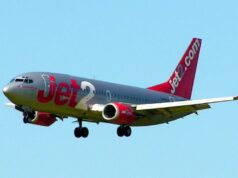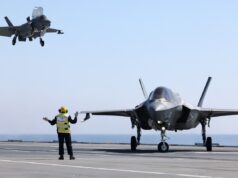The F-35A made its aerial demonstration debut at the Paris Air Show in front of crowds of thousands.
The F-35A is expected to cost $85 million, less than any fourth-generation fighter ‘in the 2019-2020 timeframe’ with the other two F-35 variants also reducing significantly in price.
The programme often comes under fire as the most expensive weapon programme in history and has been much criticised inside and outside government, in the US and partner countries. Critics argue that the plane is too expensive to operate, many blaming the procurement process. Critics also contend that the high sunk costs and political momentum make it “too big to kill”.
In 2014, the US Government Accountability Office found that the F-35 fleet would have operating costs ‘79% higher than the aircraft it was to replace’. In 2014, the FY2015 Selected Acquisition Report stated that the program cost had increased 43% from 2001, with Program Acquisition Unit Cost up 68% and Unit Recurring Flyaway up 41%.
The F-35A’s cost per flying hour at the time was reportedly $32,500 while the F-16C/D was $25,500, we understand however that each F-35A is expected to fly only 250 hours a year, compared to the F-16’s 316 hours a year, resulting in the same yearly operating cost according to the Department of Defense.
In December 2015, the Selected Acquisition Report had revised the F-35A’s cost per flying hour down to $29,806 in comparison with the F-16C/D’s antecedent of $25,541. This was reportedly the result of a decrease in the assumed cost per gallon of JP-8 fuel, a decrease in the fuel burn rate for the F-35A variant and a revised cost estimating relationship for hardware modifications.
Jeff Babione, Lockheed Martin’s programme manager for the F-35, told reporters that the cost of the F-35A will drop to about $85 million by 2019, something also reiterated in a recent statement regarding price-concerns raised by US president-elect Donald Trump.
This is understood to be thanks to efficiencies and cost-cutting manufacturing technologies. The B and C variants are also steadily reducing in cost.
By contrast, the US Navy’s F/A-18E/F Super Hornet fighter aircraft comes in at $98.3 million (2016 flyaway cost.
Jeff Babione said:
“We think that price with this capability will be unbeatable. You’ll be able to afford a fifth-generation airplane for what would be a fourth-generation price for anything else offered in the free world. The Lockheed/BAE/Northrop Grumman contractor team is hyper-focused on reducing the price of the airplane.”
As we reported at the start of last year, the F-35 programme is often labelled a “trillion-dollar black hole”, the man in charge of the project vehemently disagrees and lays to rest any fears over rising costs.
“It is a fact this program is over budget from 2001’s baseline. It’s just true. We will never underrun that number.
We will never save that money. It’s gone. What matters is since that time, what’s happened to the cost on the program? It’s gone down, not gone up. Judge the program today, not where it’s been, but where it is and where it’s going.”
Bogdan also pointed out that 2015’s selected acquisition report (SAR) noted reducing procurement costs, down by $3 billion. The average cost-per-unit in low-rate initial production lots six, seven and eight, the last three lots on contract, have fallen.
The below figures also include engines and adjust for inflation and show a continued drop in price.
F-35A conventional takeoff and landing model: $117 million, $112 million, $108 million.
F-35B “jump-jet” model: $145 million, $137 million, $134 million.
F-35C carrier variant: $134 million, $130 million, $129 million.
The F-35 Joint Program Office commented:
“Affordability is the number one priority for the F-35 program and this year’s report reflects another year with significant cost reductions and we’re not stopping there. We will continue to drive costs out of the program.
The F-35 Joint Program Office has a disciplined approach to analysing and reducing sustainment costs. Ongoing activities include conducting a sustainment business case analysis and operating a cost war room to find program savings and attack operational, sustainment and total ownership costs.
F-35 unit recurring flyaway costs have been going down with each successive lot of aircraft. Lockheed Martin and Pratt & Whitney have track records for delivering the airframe and engine below government SAR estimates and we expect this trend to continue in the future.”
Lorraine Martin, General Manager for the F-35 programme commented on the SAR:
“We are extremely pleased with the nearly $60 billion decrease in Operations and Support costs of the F-35 program during the last year alone. This is a result of a laser focus by the entire government and contractor team on reducing costs across the board whether it’s improving quality in manufacturing, increasing supply chain delivery speed, and dramatically reducing concurrency items.
We aren’t stopping here, we have numerous initiatives in place, including the Blueprint for Affordability, that will drive program costs even lower allowing us to provide our warfighters a 5th Generation F-35 jet at a 4th Generation price by the end of the decade.”
The bottom line is that overall programme costs have gone down and continue to massively decrease annually.
At peak, the F-35 will support 25,000 jobs in the UK over the next few decades and pump £1bn a year into the economy.
Cliff Robson, Senior Vice-President for the F-35 Lightning II programme at BAE Systems, said in an interview, referring to the estimated British 25,000 jobs either directly created or supported in the F-35 supply chain.
“It’s cheap when you look at what that investment is returning to the UK.”
When the jet reaches peak production, the programme will be worth some £1 billion to UK industry alone, according to research by KPMG the accounting firm. An estimated 25,000 UK jobs will be sustained across more than 500 companies in the supply chain.








Brilliant
Hopefully we will buy some of the F35A variant, perhaps enough to equip 2 or 3 front line squadrons. The F35Bs will be excellent but the additional weapons load and range provided by the ‘A’ make it the ideal replacement for Tornado. After all, why do we need STOVL variants to operate from land bases. Better to keep them for the carriers.
We have to buy all F35B variants so if the carriers run out of aircraft we have replacements pulled from the air force. The carriers have essentially crippled the air forces capabilities because of it.
So glad it debud in Paris. It’s not like there is a small crowd of paying customers who are waiting to catch a mere glimpse of it or anything.
Superb, impressive and highly agile aircraft. An aircraft that must be an essential part of future UK armed forces. Both to our highly respected RAF with the F35A and the Fleet Air Arm with the F35C aboard the carriers.
They are now vital to UK future Defence/Deterrent facilities.
MoD, don’t screw this one up, like TSR2, Nimrod & Harrier. Such tragic false economy in curtailing them all. Stick with this programme! It will be worth it.